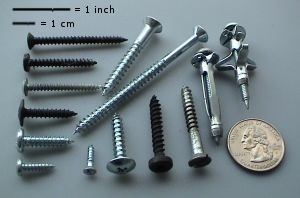 | ||
A fastener is a hardware device that mechanically joins or affixes two or more objects together. In general, fasteners are used to create non-permanent joints; that is, joints that can be removed or dismantled without damaging the joining components. Welding is an example of creating permanent joints.
Contents
Fasteners can also be used to close a container such as a bag, a box, or an envelope; or they may involve keeping together the sides of an opening of flexible material, attaching a lid to a container, etc. There are also special-purpose closing devices, e.g. a bread clip.
Some types of woodworking joints make use of separate internal reinforcements, such as dowels or biscuits, which in a sense can be considered fasteners within the scope of the joint system, although on their own they are not general purpose fasteners.
Furniture supplied in flat-pack form often uses cam dowels locked by cam locks, also known as conformat fasteners.
Items like a rope, string, wire (e.g. metal wire, possibly coated with plastic, or multiple parallel wires kept together by a plastic strip coating), cable, chain, or plastic wrap may be used to mechanically join objects; but are not generally categorized as fasteners because they have additional common uses. Likewise, hinges and springs may join objects together, but are ordinarily not considered fasteners because their primary purpose is to allow articulation rather than rigid affixment.
Other alternative methods of joining materials include: crimping, welding, soldering, brazing, taping, gluing, cementing, or the use of other adhesives. The use of force may also be used, such as with magnets, vacuum (like suction cups), or even friction.
There are three major steel fasteners used in industries: stainless steel, carbon steel, and alloy steel. The major grade used in stainless steel fasteners: 200 series, 300 series, and 400 series.
Industry
In 2005, it is estimated that the United States fastener industry runs 350 manufacturing plants and employs 40,000 workers. The industry is strongly tied to the production of automobiles, aircraft, appliances, agricultural machinery, commercial construction, and infrastructure. More than 200 billion fasteners are used per year in the U.S., 26 billion of these by the automotive industry. The largest distributor of fasteners in North America is the Fastenal Company.
When selecting a fastener for industrial applications, it is important to consider a variety of factors. The threading, the applied load on the fastener, the stiffness of the fastener, and the number of fasteners needed should all be taken into account. See below for material considerations.
Industrial Fastener Materials
There are three major steel fasteners used in industries: stainless steel, carbon steel, and alloy steel. The major grade used in stainless steel fasteners: 200 series, 300 series, and 400 series. Titanium, aluminum, and various alloys are also common materials of construction for metal fasteners.
In many cases, special coatings or plating may be applied to metal fasteners to improve their performance characteristics by, for example, enhancing corrosion resistance. Common coatings/platings include zinc, chrome, and hot dip galvanizing.
When choosing a fastener for a given application, it is important to know the specifics of that application to help select the proper material for the intended use. Factors that should be considered include:
Fastener Terminology
Screw thread: A uniform ridge on the external or internal surface of a cylinder, forming a helix around or inside the cylinder’s circumference.
External thread: thread on the outside of a fastener.
Internal thread: thread on the inside of a fastener.
Right hand thread: thread is “right hand” when, viewed axially, it winds in a clockwise and receding direction around the fastener; all threads are right hand unless otherwise designated.
Left hand thread: thread is “left hand” when, viewed axially, it winds in a counterclockwise and receding direction around the fastener; left hand threads are designated LH.
Pitch: the distance from one point on a screw thread to a corresponding point on an adjacent thread; pitch is measured parallel to its axis in the same axial plane and on the same side of the axis. Pitch is most commonly used for metric fasteners and specified in millimeters.
Threads per inch (TPI): decimal count of the number of threads on a one-inch section of fastener. Threads per inch is most commonly used for inch-measure fasteners.
Head: an enlarged section at one end of a fastener that provides a bearing surface.
Body: the unthreaded portion of a bolt between the head and the threads; some fasteners are fully threaded and therefore have no body. Shank: the portion of a headed fastener between the head and the opposite end.
Grip length: the total distance from the underside of a nut attached to a fastener to the bearing face of a fastener head.
Standards & Traceability for Military Hardware
In World War II, American screws, bolts, and nuts were not fully interchangeable with their British counterparts, and therefore would not fit British equipment properly. This, in part, helped lead to the development of numerous United States military standards and specifications for the manufacturing of essentially any piece of equipment that is used for military or defense purposes, including fasteners.
A key component of most military standards is traceability. Put simply, hardware manufacturers must be able to trace their materials to their source, and provide traceability for their parts going into the supply chain, usually via bar codes or similar methods. This traceability is intended to help ensure that the right parts are used and that quality standards are met in each step of the manufacturing process; additionally, substandard parts can traced back to their source.
